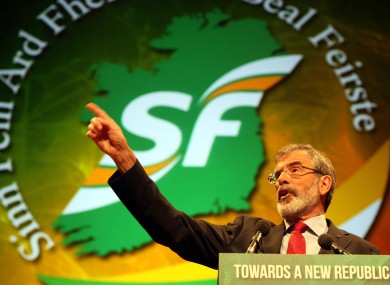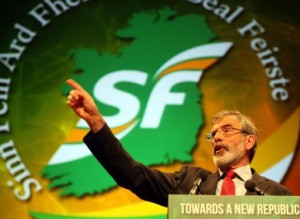A Terribly Beautiful Veil: Sinn Fein and Economic Inequality in Ireland
 Gerry Adams, Sinn Fein's leader, in 2011.
Gerry Adams, Sinn Fein's leader, in 2011.

Sunday March 27th, on the occasion of the hundredth anniversary of the 1916 Easter rising, a huge parade took place in Dublin. Hundreds of thousands came down in the streets to witness the largest military parade ever to take place in Ireland. In public remarks commemorating the events of 1916, the Taoiseach of the Republic of Ireland, as the head of government is known in the country, Enda Kenny, reminded his countrymen of the “respect and dignity” with which the memory of those who died that year was to be honored. The leader of the center-right party Fine Gael also expressed his admiration and reverence for the “principles and ideals contained in our proclamation for which they fought”.
Gerry Adams, the leader of the republican party Sinn Fein, stated that, although he “welcomed and appreciated” the Irish government’s commemoration of the Easter Rising, “the Southern state [was not] the republic proclaimed in 1916.” Sinn Fein is a left-wing party close to the Irish Republican Army, which sees itself as the standard-bearer of the Irish republican tradition. Interestingly, the group is present in both Northern Ireland and in the Republic of Ireland, and fights for the union of the island in one state.
The rise of the abstentionists and nationalists of Sinn Fein has parallels throughout Europe. In the wake of the 2008 financial crisis, Greece and Spain were faced with similar political issues with the rise of far-left parties Syriza and Podemos, respectively. However, the hard economic times that have thrown Greece and Spain into political crises recently contrast sharply with the situation of booming Ireland. The Republic’s economy saw growth of 7% last year. But impressive growth rates hide a litany of deeper structural problems that have thrown more and more people into the arms of Sinn Fein.
Padraig Pearse, one of the most prominent leaders of the 1916 uprising, read in his proclamation of the provisional Republic of Ireland that an “Ireland unfree shall never be at peace”. Clearly at the time the freedom Pearse sought implied first and foremost freedom from the British imperial yoke. Today, however, another interpretation of this declaration would appear to be more constructive: to attain true freedom, shouldn’t Ireland be free from the poverty in which so many of its citizens still wallow? Sinn Fein would answer this question in the affirmative. Apart from defending republican values, the left-wing party believes in what it has termed a “fair recovery”, a process of economic reconstruction that would benefit everyone; not just the “government and their friends at the top”, but also “hard-working, fair-minded Irish citizens”. Like Syriza in Greece and Podemos in Spain, Sinn Fein is anti-austerity and blames the deregulatory policies pursued by past governments for the destruction of the country’s economy. Parties like Sinn Fein, Podemos, and Syriza give people hope and unite them behind a common enemy: the government.
There have been precedents for parties espousing radical ideologies coming to the fore after periods of crisis. The most common example is that of the Nazi party’s rise to power on the ruins of a Weimar Germany brought to its knees by the Great Depression. Other radical and deeply confrontationist parties, such as the far-right Front National in France and Ukip in Britain have risen to prominence since the beginning of the 21st century. Even though it is difficult to demonstrate a direct causational relationship between economic crisis and the political empowerment of radicals, the correlation is not one we can afford to ignore. During hard times, people tend to turn to parties offering them change and hope. That is why radical left-wing parties are now on the front of the political stage in Ireland, Spain and Greece: they are close to the people, and make much of appearing to care for them. Unlike mainstream political groups that advocate for ‘tried-and-tested’ pre-crisis means to recharge the economic engine, Sinn Fein and radical counterparts throughout the continent appear to offer the prospect of actual, far-reaching change.
Recent electoral results from Ireland are revealing. In 2007, Sinn Fein collected 6.94% of the first choice votes, increasing this share to 9.9% in 2011 and, most recently, garnering 13.85% in 2016. The party went from having 4 seats in the Dail Éireann, or National Assembly, in 2007, to having 23 out of 158 in 2016. Sinn Fein had not polled so high since the 1920s, when it was a major political actor in the early days of the Republic. Unlike Podemos and Syriza, however, Sinn Fein isn’t a new party: it has existed for almost 100 years. One could intuitively highlight the 2008 crisis and persistent poverty as the main factors behind the party’s rising popularity, yet the relatively healthy state Ireland’s economy presents a challenge for the traditional explanation of the rise of parties as anti-establishment as Sinn Fein. Indeed, with a comparatively stellar economic growth rate of 7% in 2015, Sinn Fein’s rise seems positively paradoxical.
highlight the 2008 crisis and persistent poverty as the main factors behind the party’s rising popularity, yet the relatively healthy state Ireland’s economy presents a challenge for the traditional explanation of the rise of parties as anti-establishment as Sinn Fein. Indeed, with a comparatively stellar economic growth rate of 7% in 2015, Sinn Fein’s rise seems positively paradoxical.
Yet the fruits of last year’s economic growth were not spread evenly. In Ireland, “the rich start rich while the poor start and remain poor,” laments Philip O’Neill, an Irish citizen living in Oxford, UK. Lack of opportunity and the desperation this spawns are undeniable realities faced by many Irish citizens. One would not get this impression if they were to consult figures for unemployment in Ireland, which actually hit a 7-year low at 8.6% in December 2015 (the Spanish and Greek figures each continue to hover around 25%). However, as in an increasing number of economies at various stages of recovery from the recession of 2008, Ireland has seen deepening income inequality and an amplification of the harms related to this phenomenon. While a privileged elite lives comfortably, the majority of the population struggles to make ends meet. This was the case before the crisis, too. In 2006, the top 1% of the population earned 13 times as much as the average Irishman or woman (445,000 € against 35,000 €), while the top 10% earned about 4 times more (135,000 € ). The recession hit everyone more or less equally in Ireland, with high earners in many cases facing pay cuts. This immediate post-crisis leveling can be seen by the decrease in Ireland’s Gini coefficient, which had previously been stable at around 0.315, to 0.29. But this trend has proven momentary. Ireland’s Gini coefficient is on the rise again, indicating that incomes are stagnating for the majority of citizens even as the wages of top-earners have recovered and increased.
13 times as much as the average Irishman or woman (445,000 € against 35,000 €), while the top 10% earned about 4 times more (135,000 € ). The recession hit everyone more or less equally in Ireland, with high earners in many cases facing pay cuts. This immediate post-crisis leveling can be seen by the decrease in Ireland’s Gini coefficient, which had previously been stable at around 0.315, to 0.29. But this trend has proven momentary. Ireland’s Gini coefficient is on the rise again, indicating that incomes are stagnating for the majority of citizens even as the wages of top-earners have recovered and increased.
The Dublin-based think-tank Tasc has asserted that economic inequality in Ireland has led to broadening social exclusion and deeper poverty. The group reckons that Ireland could be on the road to US-style inequality if current trends persist. In 2010, 10% of the population suffered from food poverty. This means that 10% of the population could not afford a meal containing meat or a vegetarian equivalent every second day, could not afford a weekly roast dinner or vegetarian equivalent, and/or missed a meal in the recent days due to an inability to pay.
That Ireland appears to be on the road back to the hyper-capitalism and deregulation that battered its economy in 2008 cannot but leave one pessimistic for the country’s future. Defenders of the status quo often claim that empowering the state to squeeze the rich and enforce a more equitable distribution of resources would be ruinous, since the top earners will also tend to be the major employers. Prioritizing a reduction in inequality, they say, will inevitably stifle innovation and deprive producers of incentives to invest , hurting productivity and the wider economy. However, as stated by Nat O’Connor, Tasc’s director, “reversing inequality doesn’t hinder economic growth. In fact there are strong arguments that more equal societies – like the Nordic countries – have more productive, innovative and sustainable economies”.
, hurting productivity and the wider economy. However, as stated by Nat O’Connor, Tasc’s director, “reversing inequality doesn’t hinder economic growth. In fact there are strong arguments that more equal societies – like the Nordic countries – have more productive, innovative and sustainable economies”.
The rise of Sinn Fein and like-minded parties isn’t as surprising as it seems. People have understood that recent governments’ policies have aimed to put Ireland on the same path it was on before the crisis. They have witnessed the consequences of such policies and are fed up. While the situation of Ireland seems to have stabilized from an economic point of view, a political crisis is underway. It has been more than a month since the elections, which saw Sinn Fein come in as the country’s third party. No government is yet in place. Like the situation in Spain, Ireland’s predicament demonstrates that in spite of rosy figures, in spite of numbers, people are still suffering.
